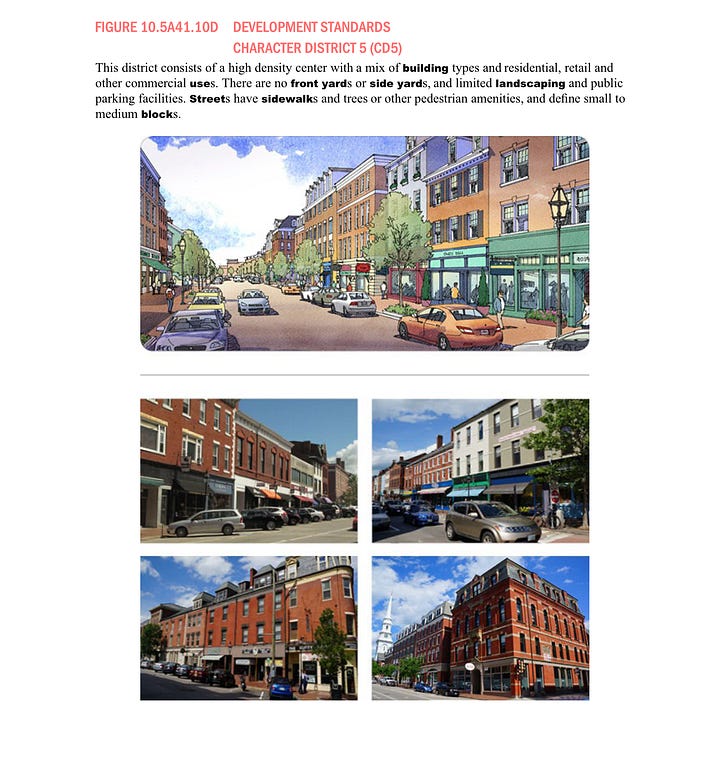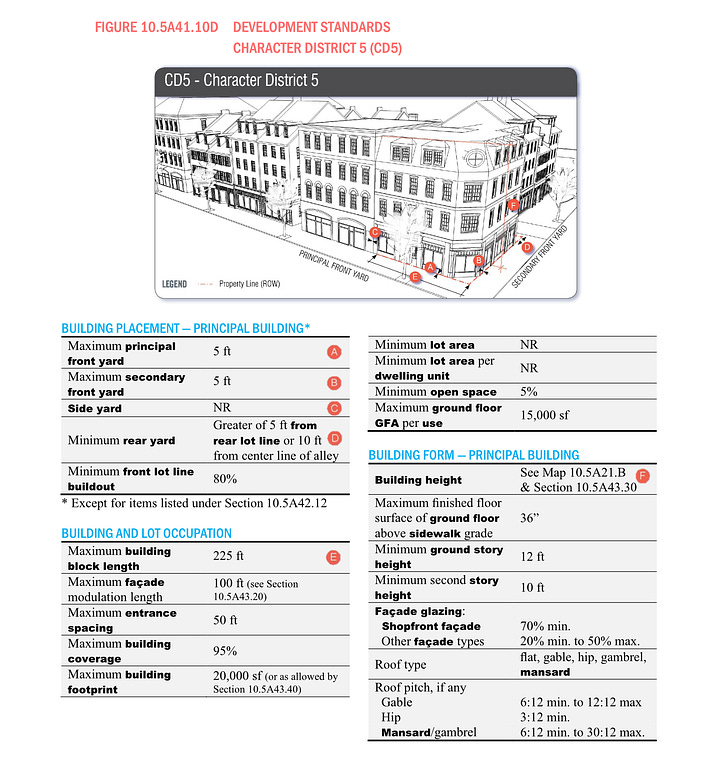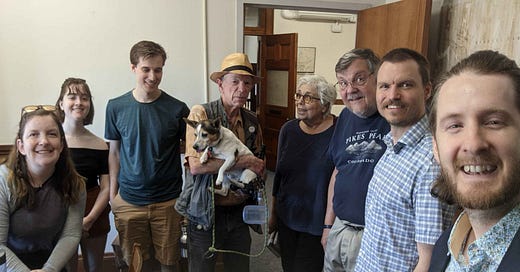Meeting #10 - How Zoning Helps and Hurts Cities
Zoning policy has huge impacts on the way that our cities approve new developments
Welcome back to the Strong Towns Seacoast Newsletter and thank you for reading. We held our tenth meeting this past Saturday to discuss zoning and learn more about how it impacts the shape of our towns and cities. I also had some people tell me that Saturday mornings are difficult for them, so I want to ask the readers what day of the week would be good to have meetings on.
Now, on to the topic. Zoning is a land use policy that divides a city into different zones that each have their own set of rules for land development. As a city planning tool, zoning goes back around 100 years with some of the earliest forms of zoning being in New York and California, but with its widespread adoption there are unfortunate instances of it being used as a tool for racial segregation. I am not looking to discuss all of the historical abuses of zoning, I would much rather talk about zoning as it is affecting our cities and towns today. One of the primary things that I want to convey about zoning is that it directly affects what can and will be built in your city and for this reason it can help or hurt your city as it grows.
Zoning is primarily enforced through several ways:
Land-use restrictions - Can you open a restaurant or a daycare on your property
Setbacks - Mandatory, empty space between the edge of a parcel and the development
Floor-Area Ratio (FAR) - The percentage ratio that a development’s square footage is allowed to use of the parcel it is on
Street Frontage - The minimum amount of distance that a parcel must consume of the neighboring street
Minimum Lot Sizes - How small a lot is allowed to be subdivided
Parking Requirements - How many parking spots are required for the type of development on this parcel
And more… - There are all kinds of restrictions that can be listed in a zoning ordinace
Zoning Can Be Useful
Let’s make the steel-man case for zoning, the best argument in favor of it that most people will agree with is the separation of incompatible land uses. Using zoning to prevent a liquor store or an adult toy shop from opening up next to a middle school is an easy sell to most people. Likewise we can also agree that putting a smoky factory in downtown or a loud racetrack in a residential area are also developments that we would most likely be in favor of preventing. One of zoning’s strengths is that it allows the community to exclude certain land uses from areas of the city. When used correctly this can help the community by preserving the value and productivity of areas by ensuring that incompatible uses are not in close proximity to one another.
Another way that zoning can be helpful is by ensuring that land parcels are divided in a way that allows for future investment, a sort of plan for planning. Imagine parcels that are divided up too small to be reasonably useful or perhaps are shaped in ways that makes development difficult to accomplish. Also, in rural areas you need larger lots to safely accommodate things like a septic tank and a well for drinking water.
For both of these, there is an admitted slippery slope to consider. While it might be a popular argument to prevent the loud racetrack in a neighborhood, you can use that same mechanism to equally prevent a wealth-creating development such as a corner store or a home business from opening up. Similarly preventing parcels from being sized “too small” is open to interpretation and while the majority might agree that 20’ by 20’ parcels might make our communities develop in strange ways, we don’t want to be too restrictive for the sake of preventing new development. In both of these cases where zoning can be helpful for a community, we need to recognize that it is possible to go too far with it and use strong discretion when applying them.


Zoning Can Be Hurtful
There are many more ways that zoning can hurt a community as it grows. The most obvious is the artificial increase in property values by restricting new developments. This happens when zoning imposes land-consuming or land-use restrictions that make it more expensive or legally impossible to build new developments in a zone and treating that part of the city as if it is “finished” developing, even if there is plenty of room for additional investment and development. This can “freeze neighborhoods in place and prevent them from being able to adapt to a community’s needs or incrementally change over time.
The legally-imposed scarcity of developed property makes the prices of the already established property increase through no merit of their own. Imagine if the only shoe store in town sold a maximum of 15 pairs of shoes per day. Do you think the demand for shoes would decrease or would the prices of shoes skyrocket? Do you think some people would find themselves shoeless?
Another way that zoning hurts a community is actually the afore mentioned slippery slope of separating land-uses. There are very exclusionary forms of zoning and even a concept of single-use zoning, which is as extreme as it gets, that prevents compatible land-uses from cohabitating. This would mean that there is a legally mandated distance between your home and things such as grocery stores, your work, the gym, etc. While a few people might love the sound of that idea, it imposes a new burden on the community in the form of increased transportation costs. Now everyone must spend additional money just to resolve the distance between places that could reasonably be co-located. Your city must now build more infrastructure to handle the increased volume of traffic that is demanding access to the transportation network and that will cost the community money to build and maintain. The cost of conducting your everyday business would increase and our communities would be financially weaker.
Rethinking Zoning
Can we find a way to keep the best parts of zoning and doing away with the bad parts? I think we can, we just need to rethink what we want out of zoning and approach the policy with an willingness to allow exploration.
Inclusionary vs Exclusionary
Many forms of zoning are exclusionary by definition, meaning that unless a specific land-use is listed as included, then it is excluded by default. What if we flipped that on its head and instead used inclusionary zoning. We could define our different zones and list out excluded uses from it and allow everything else. This would let us focus on ensuring that we are preventing the specific, incompatible land-uses and then opening the door to all other forms of development.
As a Guide to Public Investment
We can use zoning as a tool to help us plan public investment. Our zones could be indicative of levels of investment intensity within an area and we can balance that with the amount of private investment surrounding it. Zone 1 could be low public investment, with a focus on maintaining current infrastructure and little else while something like Zone 5 could be a much higher level of investment with things like access to transit, parks, and other amenities that are expensive for the city to offer. This would help us match our public and private investment to one another and allow our zones to grow and develop over time.
As a Manager on the Rate of Change
At the moment a setback is often a specified distance such as 20’ or 40’, but what if instead it was a percentage of your neighbor’s current setback? If your neighbors have a 40’ setback, perhaps we could set a percentage of 80% or some similar number that indicates that your setback is 80% of 40’ for a result of 32’. Then, once you have moved the needle to 32’, a fellow neighbor could now move up to 80% of 32’. This would allow our zones to grow in density over time, but at a rate that respects the surrounding developments. Each time a neighbor invests further into their property and moves the setback, it incrementally steps forward.
Wrapping Up
I hope that this has given you some insights and ideas on how zoning can be modified to help our communities incrementally develop, grow in wealth, and adapt over time. One last thing I’ll mention is that the downtowns of our cities such as Portsmouth and Dover grew up in a time before zoning. It was built through a series of incremental investment over time starting out as a few shacks that became homes and a trail that became a dirt road. As the town grew up, those homes became buildings and that dirt road was paved. At the moment with our current zoning policies, we could not duplicate that incremental investment that led to the wonderful downtowns that we enjoy exploring. Let’s change that and rethink how we are applying zoning.
Strong Towns Seacoast Group Updates
Another topic that we discussed in this meeting is opening up the Strong Towns Seacoast group to people who are interested in being more involved. At the moment, I am the primary organizer and decide what the newsletter and meeting topics will be, but I want this group to be influenced by more than just myself. Right now I am looking to find people who are interested in volunteering time to help the group strategize on how best to tackle advocacy on Strong Towns issues. If you are reading this and are interested in helping our group do any of the following:
Write Articles
Be Active on Social Media
Visualize Data
Create Educational Content
Strategize on Outreach
Please let me know, I am hoping to grow the group with people who want to see Strong Towns ideas in the Seacoast Region. You can email me at:
StrongTownsSeacoast@Polymathic.Company






I like the idea of making required setbacks dependent on existing setbacks. Seems like that'd be an improvement over mandating fixed distances. It'd be a bit harder to implement, because of the need to record and distribute the information. But we've got the tech to reasonably do that now.